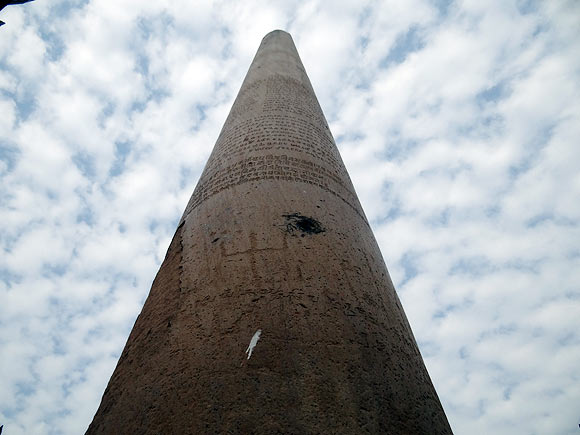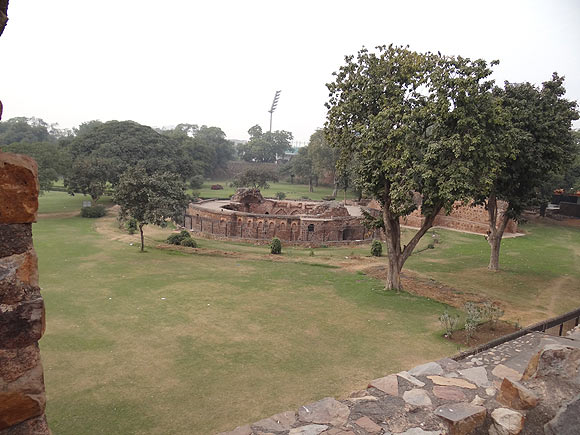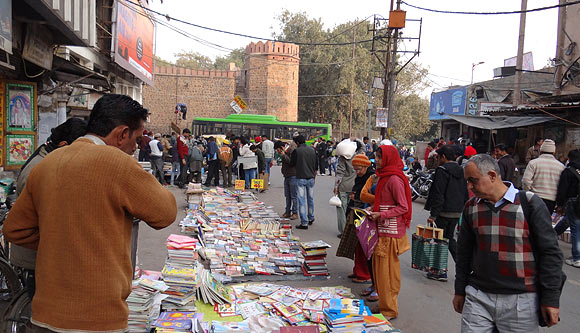 | « Back to article | Print this article |
PICS: The Djinns and magnificent ruins of Firozabad
Rediff reader Nirdesh Singh recounts how mesmerised he was after visiting Delhi's fifth city -- Firozabad
Delhi's history teaches us a lot. It is about getting knocked down, getting back up, dusting off yourself and being ready for the next battle. Delhi is about rising like a phoenix from the ashes.
William Dalrymple, author of City of Djinns: A Year in Delhi, writes in the prologue: Just as the Hindus believe that a body will be reincarnated over and over again until it becomes perfect, so it seemed Delhi was destined to appear in a new incarnation century after century.
The present times can be called the eighth reincarnation. Delhi has been plundered, pillaged and burnt to the ground only to be built back stronger, richer and more splendid; but in a way unwittingly becoming attractive to the next invader. Delhi teaches us resilience and the ability to bounce back like the proverbial cat with nine lives.
PICS: The Djinns and magnificent ruins of Firozabad
According to recorded historical facts Delhi has seen the establishment of seven cities, if we do not consider the mythological city of Indraprastha believed to be buried under the present Purana Qila. These seven cities are: Qila Rai Pithora, Mehrauli, Siri, Tughlaqabad, Firozabad, Shergarh and Shahjahanabad.
Firoz Shah Tughlaq (1351-1388) succeeded his cousin Mohammad bin Tughlaq and decided to build his own capital away from Tughlaqabad and Jahapanah. He was a renowned builder who built hunting lodges, mosques, reservoirs and colleges in and around Delhi. Some of his other well known monuments lie in the Hauz Khas area along with his tomb. He also added top two floors on Qutab Minar after it was damaged by lightning and repaired Suraj Kund.
PICS: The Djinns and magnificent ruins of Firozabad
Firozabad extended from Hauz Khas to Pir Ghalib in north ridge area and was the first city that was built on the banks of river Yamuna partly to solve the problem of water scarcity experienced in Tughlakabad. It was Mohammad-bin-Tughlaq's bad luck that both his capitals -- Tughlaqabad in Delhi and Daulatabad in Aurangabad -- were hit with water scarcity problems.
Firozabad's Kotla (fortress or citadel) western gate is protected by bastioned walls. Once inside you notice that most of the citadel is in ruins. There are few structures with surviving roofs. All you see are the shells of ruined structures, exposed subterranean passages, low rubble masonry walls and stumps that were once pillars to magnificent palaces and halls. Also seen are few structures with pyramid roofs. Ten years after Firoz Shah's death, Taimur arrived on his plunder excursion in December 1398, pillaged the city, prayed at the mosque and decamped with the goodies. Later, successive rulers dismantled the surviving structures and used the stone in the construction of Shahjahanabad and other structures.
Main features of the citadel are the Ashoka Pillar, Jami Masjid and the Baoli which largely have survived.
PICS: The Djinns and magnificent ruins of Firozabad
Pyramid of Cells is a three tiered diminishing pyramid like structure with the Ashok Pillar towering on top inscribed with edicts in Pali. The pillar was originally erected in Ambala by Emperor Ashok. The thirteen metre tall pillar is made of polished sandstone and weighs about 27 tonnes. When the sun rays falls on the pillar it glints like brass. Another Ashok Pillar brought from Meerut was installed in the ridge area of North Delhi.
Next to the pillar is the Jami Masjid. The masjid has entrance from the north with stairs leading up. Only the south & west walls survive. Friday prayers are held in the courtyard. There are underground accessible calls below the structure. Timur too prayed here and was so impressed with the architecture that he built a similar mosque in Samarkand. The loot financed it and the Delhi workers taken prisoners as spoils of war built it.
PICS: The Djinns and magnificent ruins of Firozabad
Few steps away from the pillar and the masjid is the baoli or a stepwell. Presumably there used to be elaborate piping system connecting the baoli to the Yamuna. The palace walls on the east were flanked by the flowing river. Now Yamuna has shifted eastwards. Urban legend has it that about six years ago a teenager urinated in the baoli while bathing. The resident Djinns were not happy and drowned the boy. Since then the baoli has been cordoned off.
Nothing beats the romance and magic of visiting a monument in Delhi on a wintry Sunday afternoon. The light December breeze has cleared the smog. The air seems almost crisp. Kotla Firoz Shah is an oasis in the middle of the city. It is hard to imagine that exactly 614 years ago on an equally beautiful December day this fortress was being plundered. Soak in the atmosphere sprawled on the green grass under the flitting sun. You can see Delhi's first skyscraper Vikas Minar in the south, the IG Stadium in the east, floodlights of Firoz Shah Kotla Stadium just yards away, and for company you have crows, mynahs, eagles, dogs and even cats. Chat up the security guard for nuggets of information.
PICS: The Djinns and magnificent ruins of Firozabad
Apparently, this is the only place in Delhi supposed to be the abode of Djinns or spirits. Believers come and light up diyas and incense sticks. Some people even leave written requests. The steady stream of believers assures that wishes are being granted by the Djinns. Thursday is the day when most people come with their petitions and leave offerings. It is believed that the Djinns love Delhi so much that they cannot bear to see it deserted. The day beliefs die, city dies and you die. This is your city. You were born here. You are a link in the continuum stretching over several millenniums. Visiting Delhi's heritage is like connecting with your past; it is connecting your soul and spirit with the spirit of your city. You are walking the same ground people who built this city walked on. Delhi has been attracting people through ages: people who were welcomed, people who assimilated; people who provided their own colour and texture to the canvas that Delhi is. Once in a while we need to take this walk. Djinns will love it.
Getting there
Indraprashtha or Pragati Maidan are the nearest metro stations from where you can walk or take an auto.
Kotla Firoz Shah is a place which will grow on you gradually. So two hours will just fly away. Walk out of the gates and see the Khooni Darwaza built on the traffic island on Bahadur Shah Zafar Marg. Few yards away Delhi Gate welcomes you to Delhi's seventh city of Shahjahanabad. Pick a book in the Sunday Book Bazaar on the sidewalks of Darya Ganj. In the evening curl up with the book to cap a perfect Delhi winter day.




